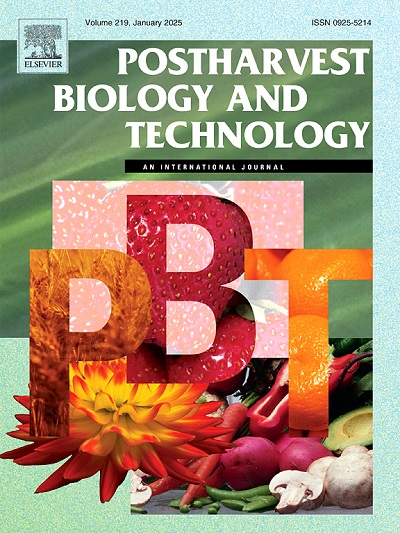冷等离子体处理通过诱导活性氧清除系统来维持杏果实的抗氧化能力和细胞膜完整性
IF 6.8
1区 农林科学
Q1 AGRONOMY
引用次数: 0
摘要
采后贮藏质量是水果行业关注的主要问题,它直接影响到消费者的接受程度和市场价值。本研究探讨了低温等离子体处理(30 kV、93 kV和150 kV)对杏果实贮藏品质的影响,并探讨了活性氧(ROS)代谢和抗坏血酸-谷胱甘肽(AsA-GSH)循环的调控机制。与对照(CK)相比,CP处理有效降低了果实腐烂率,延缓了总可溶性固形物(TSS)和可滴定酸度(TA)的下降。30 kV处理对保鲜效果影响较小,而150 kV处理对果实表面造成不可逆损伤。然而,93 kV处理诱导了适当ROS水平的产生,触发了ROS代谢系统的防御反应,上调了抗氧化酶超氧化物歧化酶(SOD)、过氧化氢酶(CAT)、过氧化物酶(POD)、抗坏血酸过氧化物酶(APX)、谷胱甘肽还原酶(GR)、脱氢抗坏血酸还原酶(DHAR)和单脱氢抗坏血酸还原酶(MDHAR)的基因表达和酶活性。促进了果实总酚、总黄酮、谷胱甘肽(GSH)、抗坏血酸(AsA)等抗氧化物质的合成,提高了果实整体抗氧化能力。这有效地降低了过氧化氢(H2O2)和超氧阴离子(O2·毒血症)的水平,从而降低了细胞膜通透性(CMP)和丙二醛(MDA)的含量。综上所述,93 kV CP处理通过调节活性氧稳态和AsA-GSH循环,减轻了细胞和线粒体膜的氧化损伤,有效地维持了杏果实的贮藏品质。本文章由计算机程序翻译,如有差异,请以英文原文为准。
Cold plasma treatment maintains antioxidant capacity and cell membrane integrity in apricot fruit by inducing reactive oxygen species scavenging systems
Postharvest storage quality is a major concern in the fruit industry, which directly affects consumer acceptance and market value. In this research, we explored the impacts of cold plasma (CP) treatments (30 kV, 93 kV, and 150 kV) on storage quality of apricot fruit, and explored the regulatory mechanisms of reactive oxygen species (ROS) metabolism and ascorbate-glutathione (AsA-GSH) cycling. Compared with control (CK), CP treatment effectively decreased fruit decay incidence, and delayed the decline in total soluble solids (TSS) and titratable acidity (TA). The 30 kV treatment had relatively little influence on maintaining freshness, while 150 kV treatment caused irreversible damage to fruit surface. However, 93 kV treatment induced the generation of appropriate ROS levels, triggering the defense response of the ROS metabolic system, which upregulated gene expression and enzyme activities of antioxidant enzymes superoxide dismutase (SOD), catalase (CAT), peroxidase (POD), ascorbate peroxidase (APX), glutathione reductase (GR), dehydroascorbate reductase (DHAR), and monodehydroascorbate reductase (MDHAR). It also promoted the synthesis of antioxidant substances including total phenols, total flavonoids, glutathione (GSH), and ascorbic acid (AsA), enhancing overall antioxidant capacity of fruit. This effectively lowered hydrogen peroxide (H2O2) and superoxide anion (O2·⁻) levels, thereby reducing cell membrane permeability (CMP) and malondialdehyde (MDA) content. In conclusion, 93 kV CP treatment alleviated oxidative damage to cell and mitochondrial membranes by regulating ROS homeostasis and AsA-GSH cycling, effectively maintaining storage quality of apricot fruit.
求助全文
通过发布文献求助,成功后即可免费获取论文全文。
去求助
来源期刊

Postharvest Biology and Technology
农林科学-农艺学
CiteScore
12.00
自引率
11.40%
发文量
309
审稿时长
38 days
期刊介绍:
The journal is devoted exclusively to the publication of original papers, review articles and frontiers articles on biological and technological postharvest research. This includes the areas of postharvest storage, treatments and underpinning mechanisms, quality evaluation, packaging, handling and distribution of fresh horticultural crops including fruit, vegetables, flowers and nuts, but excluding grains, seeds and forages.
Papers reporting novel insights from fundamental and interdisciplinary research will be particularly encouraged. These disciplines include systems biology, bioinformatics, entomology, plant physiology, plant pathology, (bio)chemistry, engineering, modelling, and technologies for nondestructive testing.
Manuscripts on fresh food crops that will be further processed after postharvest storage, or on food processes beyond refrigeration, packaging and minimal processing will not be considered.
 求助内容:
求助内容: 应助结果提醒方式:
应助结果提醒方式:


